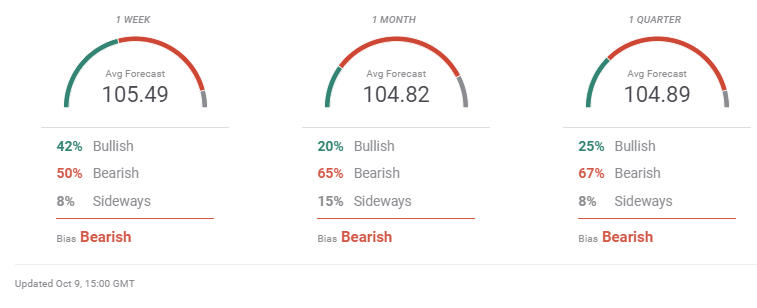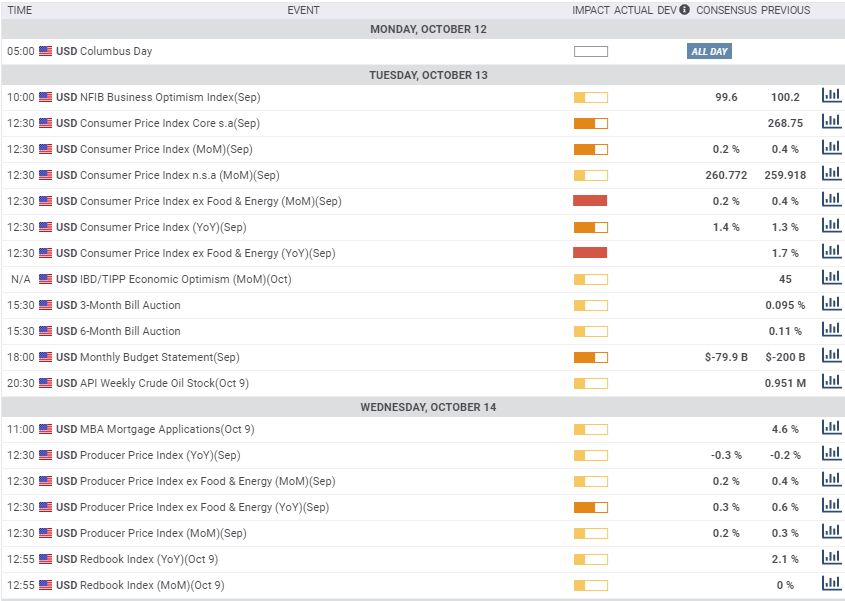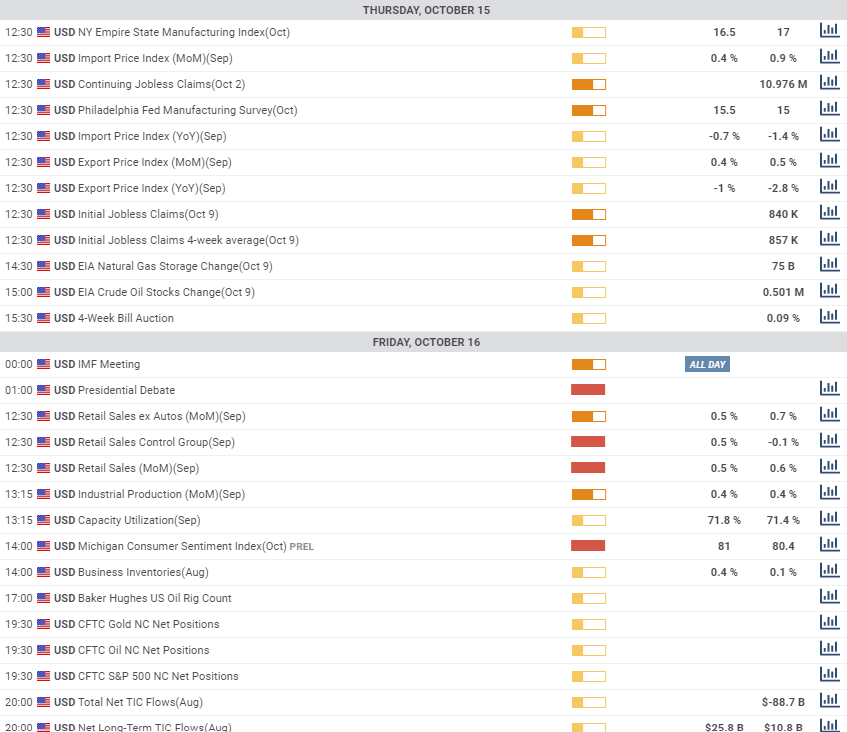- US stimulus or not was the main currency game this week.
- USD/JPY slipped slightly on Tuesday as yen absorbed the safety trade.
- Friday's revived stimulus optimism removed Wednesday's USD/JPY gain.
- FXStreet Forecast Poll is bearish out to one quarter.
The US government was the major player in the currency markets this week as the White House withdrawal from stimulus talks on Tuesday sent the markets fleeing to the dollar and then renewed negotiations on Thursday and Friday reversed the issue, leaving USD/JPY about 30 points higher over five sessions at Friday's finish.
In the Tuesday US Dollar move the USD/JPY lost a trivial amount, 0.1%, 10 points, while the EUR/USD shed 0.4%, a difference largely attributable to the yen's minor safety status.
Optimism that the Democrats and Republicans and the Trump administration can come to an agreement helped boost US equities to the best week since August, but a deal is contingent on non-economic factors.
Less than one month from the presidential vote every topic in Washington is an election topic. The proposed stimulus package will give every adult $1200, something both sides agree is necessary. But the Democrats assume, probably correctly, that the bill will help the economy and perhaps President Trump's reelection bid. They want something electoral in return.
Ms Pelosi, the Democratic Speaker of the House, has demanded federal election law revisions that would bar voter ID requirements, force states to count absentee ballots that arrive up to 10 days after the election and make same-day registration mandatory even though only 21 states currently permit it. Federal law normally trumps state and local legislation. These changes would be to laws that have historically been the province of state governments. Republicans and the President have strenuously objected to these last-minute alterations in voting conditions.
The USD/JPY stayed in the upper half of the descending channel that has been the ruling motif since the dollar panic subsided in early April. Resistance at 106.00 held in the second half of the week, but it is not a major line having been crossed and recrossed in August and the first half of September. Support at 105.30 is also weak. The line at 105.00 is stronger though largely psychological.
The long-running trend lower in the USD/JPY is short of economic rationale, but there have been no developments in the US or Japan sufficient to generate a replacement. The economic recovery in the US remains questionable despite growth estimated at 35.2% in the third quarter by the Atlanta Fed, surpassing the 31.4% annualized decline in the April, May and June period.
Japan and US statistics October 5-October 9
Japanese statistics were mixed for August but mostly better than anticipated in September.
The Jibun Bank Services Purchasing Managers' Index for September was 46.9, up from 45 in August and the best score since 51 in January. The preliminary Coincident Index for August was 79.4 on a 76.4 forecast and July's 78.3. Leading Economic Indicators for August were slightly weaker than projected 88.8 vs. 89.4 though better than July's 86.7.
The Eco Watchers Survey Outlook Survey for September was 48.3, much better than the 44.7 prediction and August's 42.4. It was the best reading since April 2019. The Current Survey came in at 49.3 well over the 40 forecast and August's 43.9.
Household Spending fell 6.9% as expected on the year to August, less than the 7.6% July decrease.
Overall, US economic statistics continued to improve, except, and it is a very important caveat, in the labor market.
Purchasing Managers' Indexes in services improved, as had manufacturing last week, with the overall rising to 57.8 in September. New orders at 61.5 far outstripped the consensus estimate for a drop to 44.7 from 56.8 in August. Employment climbed into expansion at 51.8 for the first time since February though much lower than the forecast of 58.1.
The minutes of the September FOMC meeting provided little insight into the Fed's new inflation averaging policy or its extension of rate guidance to 2023.
Initial Jobless Claims recorded 840,000 in the first week of October, 20,000 more than anticipated and the prior week was revised from 837,000 to 849,000. The four-week moving average decreased to 857,000 from 870,250.
The continuation of close to one million layoffs each week seven months after the lockdowns began and five months after the recovery started, combined with the more than 50% drop in payroll additions from August's 1.489 million to 661,000 in September, is clear evidence of a slowing labor market. It raises the possibility that the improvement in employment could reverse in coming months.
USD/JPY outlook
The USD/JPY will continue to be buffeted by the ups and downs of the stimulus negotiations in Washington until the denouement. The primary currency logic being risk-on if a deal is agreed and a lower dollar and the reverse in the event of failure.
Practice tells us that an agreement of any type will provide enough economic security for the markets to take a safety piece from the US Dollar. But this will be a temporary expedient in lieu of more concrete economic developments.
A stronger revival in the US economy, particularly in the labor market, would provide the logic for a higher dollar, but that is not signaled by current data.
Lacking a strong fundamental motive, technical arguments reign. The mid-point of the descending channel is about 104.45 while the upper border is at 106.60, leaving the downside vulnerable absent a US political boost to the greenback.
Resistance at 106.00 is minor, but the line at 106.60 coincides with the upper border of the channel. Support at 105.30 and 105.00 is weak with little trading time or activity.
If Congress cannot strike a deal, the resulting risk-off dollar will probably not break out of the upper border nor will an agreement move the pair very far down.
USD/JPY is likely to drift lower largely through the lack of any opposing force.
Japan and US statistics October 12-October 16
Japan's economic data is sparse this week. Preliminary Machine Tool Orders for September is on Monday – orders fell 23.3% in August. Industrial Production for August MoM and YoY and Capacity Utilization are issued on Tuesday. On Thursday the Tertiary Index, which tracks the domestic service sector, for August is released. None of this information is marking moving.
In the US next week sees the Consumer Price Index for September on Tuesday but with the Fed's new policy and guidance there will be no market impact.
Thursday's initial and continuing jobless claims and Friday's Retail Sales for September and Michigan Consumer Sentiment for October are the only other releases of note.
Sales have recovered from their plunge in March and April and the expected 0.5% gain following August's 0.6% increase is a return normal consumption. The GDP component control group is forecast to climb 0.5% after August's unexpected 0.1% decline. Michigan Sentiment is expected to edge higher to 81 from 80.4 in September.
Sales will be watched for any sign of weakness. With nearly 11 million Americans out of work, the essentially normal growth of consumption over the past six months is a source of wonder and concern. Any substantial over or under shoot in sales could impact the dollar.
USD/JPY technical outlook
The descending channel is the ruling scenario with no fundamental development for change on the immediate horizon. Support is scarcer and weaker than resistance and that enhances the tendency lower.
The Relative Strength Index at 49.54 dipped in the latter part of the week, but the surface disguises a lower bias in the quick return to neutral. The 21-day moving average at 105.43 is mid-way between the market close at 105.62 and weak support at 105.30 and will not hinder a decline. The 100-day day average at 106.51 reinforces the resistance line at 106.60. The distant line at 107.47 is of no current moment.
Resistance: 106.00; 106.60; 107.00; 107.60
Support: 105.30; 105.00; 104.55; 104.00
USD/JPY Forecast Poll
 Though uniformly bearish, the predicted movement in the FXStreet Forecast Poll , even as far out as one quarter, is weak. The average forecast at 104.89 is less than a figure below the week's close at 105.62. The six-month-old channel, initially begun in the slow removal of the US dollar's pandemic premium, has continued without acquiring any new logic. Its hold on market direction is more a matter of existence than economic reality.
Though uniformly bearish, the predicted movement in the FXStreet Forecast Poll , even as far out as one quarter, is weak. The average forecast at 104.89 is less than a figure below the week's close at 105.62. The six-month-old channel, initially begun in the slow removal of the US dollar's pandemic premium, has continued without acquiring any new logic. Its hold on market direction is more a matter of existence than economic reality.
Information on these pages contains forward-looking statements that involve risks and uncertainties. Markets and instruments profiled on this page are for informational purposes only and should not in any way come across as a recommendation to buy or sell in these assets. You should do your own thorough research before making any investment decisions. FXStreet does not in any way guarantee that this information is free from mistakes, errors, or material misstatements. It also does not guarantee that this information is of a timely nature. Investing in Open Markets involves a great deal of risk, including the loss of all or a portion of your investment, as well as emotional distress. All risks, losses and costs associated with investing, including total loss of principal, are your responsibility. The views and opinions expressed in this article are those of the authors and do not necessarily reflect the official policy or position of FXStreet nor its advertisers. The author will not be held responsible for information that is found at the end of links posted on this page.
If not otherwise explicitly mentioned in the body of the article, at the time of writing, the author has no position in any stock mentioned in this article and no business relationship with any company mentioned. The author has not received compensation for writing this article, other than from FXStreet.
FXStreet and the author do not provide personalized recommendations. The author makes no representations as to the accuracy, completeness, or suitability of this information. FXStreet and the author will not be liable for any errors, omissions or any losses, injuries or damages arising from this information and its display or use. Errors and omissions excepted.
The author and FXStreet are not registered investment advisors and nothing in this article is intended to be investment advice.
Recommended Content
Editors’ Picks
AUD/USD remained bid above 0.6500

AUD/USD extended further its bullish performance, advancing for the fourth session in a row on Thursday, although a sustainable breakout of the key 200-day SMA at 0.6526 still remain elusive.
EUR/USD faces a minor resistance near at 1.0750

EUR/USD quickly left behind Wednesday’s small downtick and resumed its uptrend north of 1.0700 the figure, always on the back of the persistent sell-off in the US Dollar ahead of key PCE data on Friday.
Gold holds around $2,330 after dismal US data

Gold fell below $2,320 in the early American session as US yields shot higher after the data showed a significant increase in the US GDP price deflator in Q1. With safe-haven flows dominating the markets, however, XAU/USD reversed its direction and rose above $2,340.
Bitcoin price continues to get rejected from $65K resistance as SEC delays decision on spot BTC ETF options

Bitcoin (BTC) price has markets in disarray, provoking a broader market crash as it slumped to the $62,000 range on Thursday. Meanwhile, reverberations from spot BTC exchange-traded funds (ETFs) continue to influence the market.
US economy: slower growth with stronger inflation

The dollar strengthened, and stocks fell after statistical data from the US. The focus was on the preliminary estimate of GDP for the first quarter. Annualised quarterly growth came in at just 1.6%, down from the 2.5% and 3.4% previously forecast.





